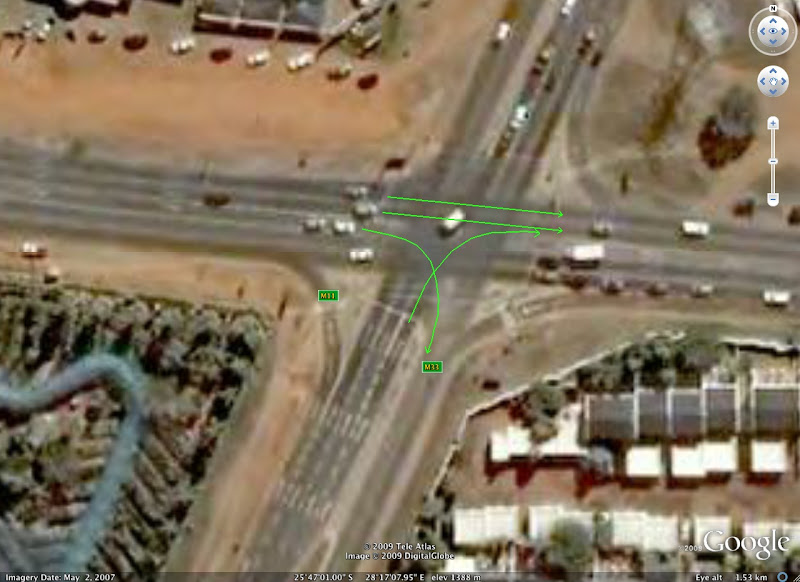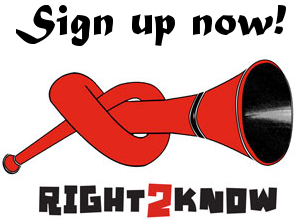Driving in South Africa - Pt 3
Read Part 1, Part 2 if you haven't yet.
Intersections
Who does not get frustrated at an intersection where you have to wait for oncoming traffic before you can turn, especially when that intersection does not have a green flashing arrow to allow you freedom to turn while oncoming traffic must stop for you? Of course, then you have to wait for the oncoming traffic to pass before turning and, in the event of the traffic light turning red, then you quickly have to turn before the traffic starts moving on the road perpendicular to your own.
 In this scenario, South Africans are not very disciplined. Since many of these intersections without a flashing green arrow on the traffic light only allow about 2 or maybe 3 cars to go through after oncoming traffic has to stop for the red light, many people take the liberty of quickly "slipping" through.
In this scenario, South Africans are not very disciplined. Since many of these intersections without a flashing green arrow on the traffic light only allow about 2 or maybe 3 cars to go through after oncoming traffic has to stop for the red light, many people take the liberty of quickly "slipping" through.
For those who do this "slipping" through the red light in order to turn, without mentioning the obvious accident scenario, there are other problems with this. One of those problems is that "slipping" through like this on a red light causes a slowing down of the traffic coming from the sides. Now they have to wait for Mr/Mrs Selfish before they can go, slowing traffic down at the back, ensuring that the number of cars that should have made it through that green light could not make it. What this causes at the previous traffic light is a heaping up of cars, many of whom now get stuck in the middle of that intersection, blocking traffic from the sides. I hope you can see the cumulative effect of "slipping" through!
Even though some lights do not allow for many cars to make their turns, it doesn't give the driver the right to to make his turn when the light has turned red!
So, how should this scenario be approached in an equitable way? When you are at such an intersection waiting to turn across oncoming traffic, move your vehicle as far forward as safely possible. This way, more cars (1 or 2) can also get across the solid white stop line at the traffic light. As a result, all the cars that have crossed that white solid line can turn. The problem comes when the light has turned red. All cars that are still behind the solid white stop line should stay put. That means if you are behind that line and the light turns red, you may not go any longer! You are jumping a red light and should be fined for doing so! Do not see this as an opportunity to stick to the tail of the car in front of you and so "slip" through! By "slipping" through like this, you affect the lanes where the light has just gone green.
Lane changing

The question, of course, is which lane should you enter if you turn into a double-(multi) lane road? This is simple, really. The picture here explains it in a visual way. If I am travelling from north to south and I want to turn west, I should enter the lane on the right of the double lane road as indicated by the green line in the image. This means that if there is a flow of vehicles north/south, and there are vehicles both from north and south wanting to turn west, then those vehicles from the south should keep to the left-hand lane and the vehicles from the north should be able to use the right-hand lane. That is what the green lines portray. That means that the red line in the image becomes a no-no for the person coming from the north wanting to turn west. The simple rule here is to turn into the lane closest to you.
Why is this important? Well, the obvious reason for this is traffic flow. In this way, cars coming from the north turning west do not have to wait for cars coming from the south to first turn before they can go, helping with traffic flow. Obviously, when 2 lanes are allowed to turn, as is the case coming from the south, then those coming from the north must wait.
Once you have turned into your lane, you then change to the lane that you need to be in, after you have indicated your intended lane change with the relevant indicator.
Driving is all about ettiquette, and agressive driving is pure selfishness. Rather than making it easier for yourself by being a rude and crude driver, think of those around you. The roads in South Africa do not belong to a certain group only. It is part of an infrastructure built for all South Africans.
In essence, be a thoughtful and kind driver, not an oaf!
Continue with Part 4.
Intersections
Who does not get frustrated at an intersection where you have to wait for oncoming traffic before you can turn, especially when that intersection does not have a green flashing arrow to allow you freedom to turn while oncoming traffic must stop for you? Of course, then you have to wait for the oncoming traffic to pass before turning and, in the event of the traffic light turning red, then you quickly have to turn before the traffic starts moving on the road perpendicular to your own.
 In this scenario, South Africans are not very disciplined. Since many of these intersections without a flashing green arrow on the traffic light only allow about 2 or maybe 3 cars to go through after oncoming traffic has to stop for the red light, many people take the liberty of quickly "slipping" through.
In this scenario, South Africans are not very disciplined. Since many of these intersections without a flashing green arrow on the traffic light only allow about 2 or maybe 3 cars to go through after oncoming traffic has to stop for the red light, many people take the liberty of quickly "slipping" through.For those who do this "slipping" through the red light in order to turn, without mentioning the obvious accident scenario, there are other problems with this. One of those problems is that "slipping" through like this on a red light causes a slowing down of the traffic coming from the sides. Now they have to wait for Mr/Mrs Selfish before they can go, slowing traffic down at the back, ensuring that the number of cars that should have made it through that green light could not make it. What this causes at the previous traffic light is a heaping up of cars, many of whom now get stuck in the middle of that intersection, blocking traffic from the sides. I hope you can see the cumulative effect of "slipping" through!
Even though some lights do not allow for many cars to make their turns, it doesn't give the driver the right to to make his turn when the light has turned red!
So, how should this scenario be approached in an equitable way? When you are at such an intersection waiting to turn across oncoming traffic, move your vehicle as far forward as safely possible. This way, more cars (1 or 2) can also get across the solid white stop line at the traffic light. As a result, all the cars that have crossed that white solid line can turn. The problem comes when the light has turned red. All cars that are still behind the solid white stop line should stay put. That means if you are behind that line and the light turns red, you may not go any longer! You are jumping a red light and should be fined for doing so! Do not see this as an opportunity to stick to the tail of the car in front of you and so "slip" through! By "slipping" through like this, you affect the lanes where the light has just gone green.
Lane changing

The question, of course, is which lane should you enter if you turn into a double-(multi) lane road? This is simple, really. The picture here explains it in a visual way. If I am travelling from north to south and I want to turn west, I should enter the lane on the right of the double lane road as indicated by the green line in the image. This means that if there is a flow of vehicles north/south, and there are vehicles both from north and south wanting to turn west, then those vehicles from the south should keep to the left-hand lane and the vehicles from the north should be able to use the right-hand lane. That is what the green lines portray. That means that the red line in the image becomes a no-no for the person coming from the north wanting to turn west. The simple rule here is to turn into the lane closest to you.
Why is this important? Well, the obvious reason for this is traffic flow. In this way, cars coming from the north turning west do not have to wait for cars coming from the south to first turn before they can go, helping with traffic flow. Obviously, when 2 lanes are allowed to turn, as is the case coming from the south, then those coming from the north must wait.
Once you have turned into your lane, you then change to the lane that you need to be in, after you have indicated your intended lane change with the relevant indicator.
Driving is all about ettiquette, and agressive driving is pure selfishness. Rather than making it easier for yourself by being a rude and crude driver, think of those around you. The roads in South Africa do not belong to a certain group only. It is part of an infrastructure built for all South Africans.
In essence, be a thoughtful and kind driver, not an oaf!
Continue with Part 4.














































No comments :
Post a Comment
Please provide me with your two-cents of wisdom!